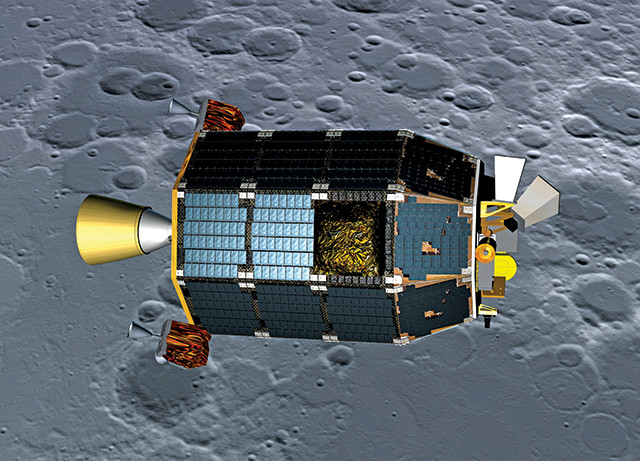
by Harvey Leifert Sunday, March 27, 2016

NASA's Lunar Atmosphere and Dust Environment Explorer (LADEE) spacecraft orbits near the moon's surface in this illustration. Credit: NASA Ames/Dana Berry
LADEE — pronounced “laddie” and short for Lunar Atmosphere and Dust Environment Explorer — was among the shortest-lived of NASA’s successful satellites. Launched on Sept. 7, 2013, it crashed onto the moon’s surface, as intended, on April 17, 2014, after six months orbiting the moon. Data collected by LADEE have already greatly expanded our understanding of the atmosphere of the moon and other bodies in the solar system; the spacecraft also made a number of unexpected discoveries, some of which were presented at the fall meeting of the American Geophysical Union (AGU) in San Francisco last December.
LADEE orbited at a low altitude of roughly 50 kilometers, scanning the moon’s tenuous atmosphere — more precisely, its “surface-bounded exosphere” — to determine for the first time the exosphere’s composition and dynamics. The density of the moon’s exosphere is similar to the density of Earth’s atmosphere at the altitude at which the International Space Station orbits, according to NASA; it is, functionally, a vacuum. But it is likely similar to those on other airless solar system bodies, including Mercury, Europa, Io, both Martian moons, large asteroids and Kuiper Belt objects such as Pluto, according to Richard Elphic, LADEE project scientist at NASA Ames Research Center at Moffett Field in California. Understanding the moon’s exosphere would thus help researchers understand exospheres on other solar system bodies. Elphic and colleagues presented results of the mission at a press conference at the AGU meeting.
As for the moon, LADEE has determined that the three most abundant elements in its exosphere are, in descending order, helium, neon and argon. These noble gases leak to the surface from the moon’s deep interior, Elphic said. Of the tiny fraction of the exosphere not accounted for by those three, water and sodium predominate, with a dozen other elements making up the remainder. Sodium, although occurring in minute amounts, is ideal for the study of the exosphere, because of the bright yellow line it provides in spectroscopic analyses, said Anthony Colaprete of NASA Ames. It is also one of the elements most easily liberated by incoming particles and meteoroid impacts, he said.
The Ultraviolet-Visible Spectrometer (UVS), one of three instruments aboard LADEE, studied what happened when meteoroids ranging in size from grains of sand to small rocks hit the moon’s surface at speeds up to 34 kilometers per second and were mostly vaporized. Their impacts on the moon, especially during the Geminid meteor shower in mid-December 2013, affected the composition, state and density of the exosphere, according to Colaprete, who managed the UVS instrument. During the Geminids, he said, the amount of sodium and potassium in the exosphere showed a “spectacular increase,” by almost a factor of two. This effect had been hypothesized in the past, but could not be confirmed from Earth-based observations, he said. UVS observations also showed that potassium levels on the moon’s surface increased during the Geminid shower.
Data from UVS are now being compared with existing data from studies of lunar regolith — the surface layer of dust and loose pebbles and rocks — to help scientists understand the influence of meteoroid showers on the moon’s surface, Colaprete said. (The previously available data were provided by samples of the regolith the Apollo astronauts, as well as observations made by NASA’s Lunar Reconnaissance Orbiter.)
Scientists are interested in compositional changes at the surface and in the exosphere because they can shed light on the processes causing the changes. Bombardment by meteoroids is one such agent of change; cosmic rays and other particles streaming through space, like solar photons, also play roles. These energetic processes can liberate sodium and other atoms from minerals on the surface and send them bounding through the exosphere. Eventually, the ions settle back to the regolith, or, if the energy imparted to sodium atoms through the solar wind is sufficient to achieve escape velocity, the ions are launched into space, in a process known as sputtering, according to Thomas Morgan of the NASA Goddard Space Flight Center in Greenbelt, Md. Morgan said scientists want to learn the relative importance of each kind of impact on the regolith and to predict how much sodium each of them releases to the exosphere.
Another thing scientists learned from the LADEE mission was how rhythmic the changes in the moon’s exosphere are: Ejection of sodium and potassium atoms from the surface appears to occur on daily, monthly and annual cycles, reported LADEE mission member Menelaos Sarantos of the University of Maryland, Baltimore County. UVS data revealed — to the surprise of scientists, he said — that these atoms are repeatedly launched into the exosphere by incoming particles, and yet never react with other elements, as they do readily on Earth. Rather, the atoms return to the regolith as free metals, awaiting the next jolt from another incoming particle. These phenomena and others yet to be analyzed, such as the role of water vapor in the exosphere, will aid astronomers studying other solar system bodies with exospheres, the researchers said.
In its short lifetime, LADEE provided more data on the moon’s exosphere and regolith than scientists have been able to analyze so far, so the work continues, Elphic said. LADEE’s twin goals of better understanding the moon and providing insights into the behavior of exospheres on other solar system bodies have already been achieved, but there is plenty more to be learned from the mission of this unique spacecraft.
© 2008-2021. All rights reserved. Any copying, redistribution or retransmission of any of the contents of this service without the expressed written permission of the American Geosciences Institute is expressly prohibited. Click here for all copyright requests.